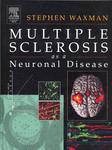-Contents-
1 The structure of myelinated axons in the CNS 1
2 Dialogues : communication between axons and myelinating glia 29
3 Molecular specializations at the glia-axon interface 45
4 Potassium channel organization of myelinated and demyelinated axons
57
5 The roles of potassium and calcium channels in physiology and
pathophysiology of axons 69
6 The conduction properties of demyelinated and remyelinated axons 85
7 Altered distributions and functions of multiple sodium channel
subtypes in multiple sclerosis and its models 101
8 Na[superscript +] channel reorganization in demyelinated axons 119
9 Ion currents and axonal oscillators : a possible biophysical basis
for positive signs and symptoms in multiple sclerosis 131
10 Clinical pharmacology of abnormal potassium channel organization
in demyelinated axons 145
11 Pathology of neurons in multiple sclerosis 153
12 Axonal degeneration in multiple sclerosis : the histopathological
evidence 165
13 Natural history of multiple sclerosis : when do axons degenerate?
185
14 Brain atrophy as a measure of neurodegeneration and
neuroprotection 201
15 MRI-clinical correlations in multiple sclerosis : implications for
our understanding of neuronal changes 215
16 Electrophysiological correlates of relapse, remission, persistent
sensorimotor deficit, and long-term recovery processes in multiple
sclerosis 227
17 Inflammation and axon degeneration 241
18 Nitric oxide and axonal pathophysiology 255
19 Molecular mechanisms of calcium influx in axonal degeneration 275
20 Axonal damage and neuron death in multiple sclerosis and
experimental autoimmune encephalomyelitis : the role of calpain 293


